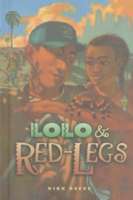
When eleven-year-old Lolo captures a tarantula, it turns an ordinary summer into a series of adventures that take him and his friends beyond their Mexican-American neighborhood in East Los Angeles.

When eleven-year-old Lolo captures a tarantula, it turns an ordinary summer into a series of adventures that take him and his friends beyond their Mexican-American neighborhood in East Los Angeles.
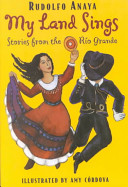
A collection of ten original and traditional stories set in New Mexico, including “Lupe and la Llorona,” “The Shepherd Who Knew the Language of Animals,” and “Coyote and Raven.”
See the review at WOW Review, Volume 3, Issue 2
Once upon a time, in a land far away…These stories have journeyed far — over mountains, deserts, and oceans — carried by wind, passed on to us by our ancestors. Now they have found their way to you.A sly fox, a bird of a thousand colors, a magical set of bagpipes, and an audacious young girl…A mixture of popular tales and literary lore, this anthology celebrates Hispanic culture and its many roots — Indigenous, African, Arab, Hebrew, and Spanish.F. Isabel Campoy and Alma Flor Ada have retold twelve beloved stories that embody the lively spirit and the rich heritage of Latino people.The work of four leasing Latino artists and illustrators highlights this unforgettable collection.
Offers a collection of poems in English and Spanish that tell of a young Mexican-American girl’s dream to overcome her family difficulties and economic hardships in order for her to achieve her goal of becoming a teacher.
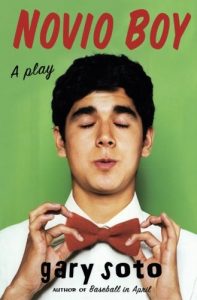 Ninth grader Rudy has a date with eleventh grader Patricia. Now he has to come up with the money, the poise, and the conversation to carry it off. This one-act play, by turns heartwarming and heart-wrenching, follows Rudy from his desperate search for guidance through the hilarious date itself–all the way to its happy conclusion. Includes a glossary of Spanish phrases.
Ninth grader Rudy has a date with eleventh grader Patricia. Now he has to come up with the money, the poise, and the conversation to carry it off. This one-act play, by turns heartwarming and heart-wrenching, follows Rudy from his desperate search for guidance through the hilarious date itself–all the way to its happy conclusion. Includes a glossary of Spanish phrases.
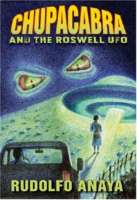
In this second ChupaCabra mystery, Professor Rosa Medina has just arrived in Santa Fe where she meets Nadine, a mysterious sixteen-year-old who insists that the two of them travel to Roswell, New Mexico. Nadine is convinced that C-Force, a secret government agency, has decoded the DNA of ChupaCabra and an extraterrestrial. If the two genomes are combined, a new and horrific life form will be created.In this fast-paced mystery, Anaya expands the ChupaCabra folklore into a metaphor that deals with the new powers inherent in science. Is ChupaCabra a beast in Latino folktales, used to frighten children, or a lost species being manipulated by C-Force? Rosa\’s life hangs in the balance as she and her young accomplice try to find a way to stop C-Force before its mad scientists create a monster.
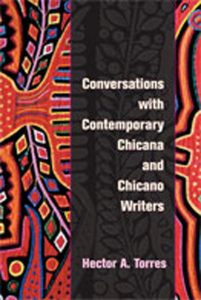 Hector A. Torres conducted these interviews with today’s popular Chicano/a writers, asking each about language and life between languages, about the creative drive that has guided them in their craft and commits them to their art. In sharing their responses, Torres reveals a brief biography of each author and a concise examination of their writings. Taking their stories and essays individually and collectively, Torres explains how each author reiterates issues that have concerned Mexican Americans since at least 1848. Chicano/a authors know that an abundance of politics can spoil a story, as can too little. The writers included here span historical terrain, first, under the shadow of Manifest Destiny and, then, under the America’s imperial sovereignty stance. Interviewees include Rolando Hinojosa (“I Reflect the Way Valleyites Act and React”), Arturo Islas (“I Don’t Like Labels and Categories”), Erlinda Gonzales-Berry (“On the New Mexican Borderlands”), Gloria Anzaldúa (“The Author Never Existed”), Ana Castillo (two separate interviews), Sandra Cisneros (two separate interviews), Pat Mora (“I Was Always at Home in Language”), Richard Rodriguez (“I Don’t Think I Exist”), Demetria Martinez (“To Speak as Global Citizens”), and Kathleen Alcalá (“To Tell the Counternarratives”).
Hector A. Torres conducted these interviews with today’s popular Chicano/a writers, asking each about language and life between languages, about the creative drive that has guided them in their craft and commits them to their art. In sharing their responses, Torres reveals a brief biography of each author and a concise examination of their writings. Taking their stories and essays individually and collectively, Torres explains how each author reiterates issues that have concerned Mexican Americans since at least 1848. Chicano/a authors know that an abundance of politics can spoil a story, as can too little. The writers included here span historical terrain, first, under the shadow of Manifest Destiny and, then, under the America’s imperial sovereignty stance. Interviewees include Rolando Hinojosa (“I Reflect the Way Valleyites Act and React”), Arturo Islas (“I Don’t Like Labels and Categories”), Erlinda Gonzales-Berry (“On the New Mexican Borderlands”), Gloria Anzaldúa (“The Author Never Existed”), Ana Castillo (two separate interviews), Sandra Cisneros (two separate interviews), Pat Mora (“I Was Always at Home in Language”), Richard Rodriguez (“I Don’t Think I Exist”), Demetria Martinez (“To Speak as Global Citizens”), and Kathleen Alcalá (“To Tell the Counternarratives”).
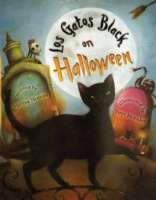
Follow los monstruos and los esqueletos to the Halloween party Under October’s luna, full and bright, the monsters are throwing a ball in the Haunted Hall. Las brujas come on their broomsticks. Los muertos rise from their coffins to join in the fun. Los esqueletos rattle their bones as they dance through the door. And the scariest creatures of all aren’t even there yet!This lively bilingual Halloween poem introduces young readers to a spooky array of Spanish words that will open their ojos to the chilling delights of the season.
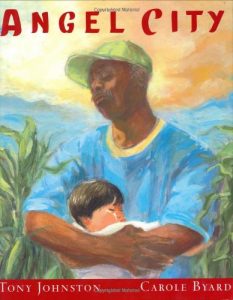 Old man Joseph never imagined a family could start this way. When he finds a baby abandoned on a lonely L.A. street, he vows to raise it as his own. He’s an old farmer and knows nothing of parenting, even less about raising a Mexican baby.Yet Joseph keeps his promise and with time he realizes that even in the darkest barrio, there is a world to explore, songs and stories to be shared. Even in the darkest barrio, there is love.
Old man Joseph never imagined a family could start this way. When he finds a baby abandoned on a lonely L.A. street, he vows to raise it as his own. He’s an old farmer and knows nothing of parenting, even less about raising a Mexican baby.Yet Joseph keeps his promise and with time he realizes that even in the darkest barrio, there is a world to explore, songs and stories to be shared. Even in the darkest barrio, there is love.
Illustrated by Caldecott-Honor Medal winner Carol Byard and beautifully told by Tony Johnston, Angel City is a moving tribute to the strength of family no matter its form.